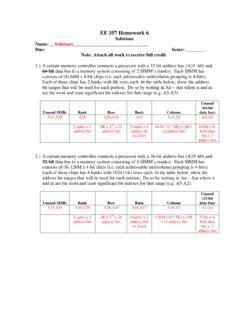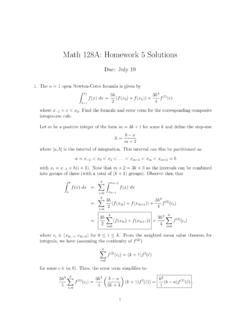Transcription of Homework Solutions for Chem 422
1 Homework Solutions for Chem 422 Chapter )Elution is the process of washing substances through a chromatographiccolumn with the mobile )The mobile phase in chromatography is the one that moves over orthrough an immobilized phase in a column or on the surface of a )The stationary phase in a chromatographic column is a solid or liquid thatis fixed in )The distribution constant (K) in chromatography is the ratio of theconcentration of the analyte in the stationary phase to its concentration inthe mobile phase when the two phases are in )The retention time (tR) for an analyte is the time between its injection ontoa column and the appearance of its peak as it elutes from the )The retention factor (k) is the ratio of the amount of analyte in thestationary phase to the amount in the mobile phase. It is generallycalculated by k = (tR - tM)/tM = tR )The selectivity factor ( ) of a column for two analytes (A eluting before B)is given by = KB/KA = k (B)/k (A) = tR (B)/tR (A).
2 H)The plate height (H) of a chromatographic column is defined by therelationship H = 2/L, where is the standard deviation of theconcentration distribution for the analyte in its elution band (in units oflength) and L is the length of the column )Longitudinal diffusion is a source of band broadening in a column in whichan analyte diffuses from the concentration center of a band to the moredilute regions on either )Eddy diffusion is a source of band broadening in a column in whichanalyte particles travel through the column by pathways that differ inlength, and hence )The resolution (Rs) of a column for two analytes (A eluting before B) isgiven by Rs = [tR(B) - tR(A)]/[(WA + WB)/2], where W is the baseline width ofa chromatographic peak in the same units as the analyte retention )The eluent in chromatography is the fresh mobile phase that carries thesample through the Solutions for Chem 422 Chapter 26 variables that lead to increased zone broadening include:1)large particle diameters for column packing2)large column diameters3)high temperatures (for gas chromatography)4)thick layers of liquid stationary phases5)very high or very low flow rates6)high viscosity mobile phase (for liquid chromatography)7)slow introduction of sample onto that affect the selectivity factor ( ) include:1)composition of the mobile phase (for liquid chromatography) 2)column temperature (for gas chromatography)3)composition of the stationary gas chromatography, the retention factor is varied by changing the columntemperature during the run (temperature programming).
3 In liquidchromatography, the retention factor is varied by changing the composition of themobile phase during the run (gradient elution). number of plates in a column for a given analyte can be determined bymeasuring the retention time (tR) and the width of a peak at its base (W) or itshalf height (W ). The number of plates is then given the peak widths will increase resolution as will increasing the peakseparation. Homework Solutions for Chem 422 Chapter 26 is a minimum in a plot of plate height versus flow rate because bandbroadening due to longitudinal diffusion effects decreases with increasing flowrate while broadening due to mobile-phase and stationary-phase mass-transfereffects increases with increasing flow rate. Since longitudinal diffusion is muchless a factor in liquid chromatography, the minimum plate height is found at amuch lower flow rate than for gas elution is a method used in liquid chromatography in which thecomposition of the mobile phase is changed continuously or in steps in order toimprove The variables that improve band separation include:1)increased column length2)variations in mobile phase composition, including changes in pH(for liquid chromatography)3)stationary phases that produce significantly different partitioncoefficients4)use of a stationary phase that selectively complexes certainanalytes5)choice of optimum temperature13.
4 Slow sample introduction leads to band Solutions for Chem 422 Chapter )Calculate the number of plates using the equation given in the answer toproblem 8 above. SpeciesNA16( )2 = 2775B16( )2 = 2472C16( )2 = 2364D16( )2 = 2523 N = 10,134b)Average N = 10,134/4 = 2534 = x 103 platesc)H = cm/2534 plates = x 10-3 )Calculate the retention factor using the equation k = (tR - tM) = ( - ) = = ( - ) = = ( - ) = = ( - ) = Solutions for Chem 422 Chapter )Calculate the resolution by the equation Rs = [tR(C) - tR(B)]/[(WB + WC)/2].Rs = ( - )/[( + )/2] = )Calculate the selectivity factor by the equation = tR (C)/tR (B). = ( - )/( - ) = )Calculate the number of plates using the equation given in the answer toproblem 8 above. ComponentNmethylcyclohexane16( )2 = 2770methylcyclohexene16( )2 = 2827toluene16( )2 = 2557 N = 8154 Average N = 8154/3 = 2718 = x 103 plates
















